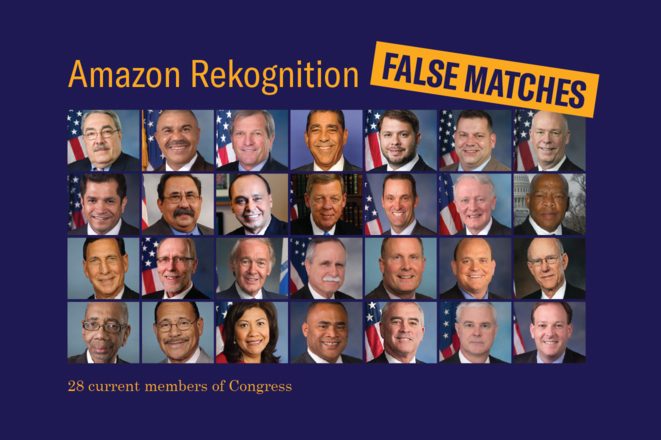
Amazon may want to go back to the drawing board for this one. A facial recognition tool the retail giant currently offers developers made quite the mistake in a test conducted by the American Civil Liberties Union (ACLU), The New York Times reports. Rather than identifying 28 members of Congress as members of the country’s legislative branch, the tool instead classified these individuals as police suspects. To make matters worse, a disproportionate number of African-American and Latino Congress members were incorrectly identified, raising questions of how far racial profiling has embedded itself even in our machine learning software.
Now, Congress wants answers. Five of the misidentified lawmakers are requesting an “immediate” meeting with Amazon CEO Jeff Bezos. On Thursday, July 26, Reps. Jimmy Gomez, John Lewis, Luis Gutierrez, and Mark DeSaulnier, as well as Sen. Edward Markey, sent letters to the online retail giant asking why they were mismatched. But beyond the personal effects of these cases of mistaken identity, the congressmen are asking for answers as to “how to address the defects of this technology in order to prevent inaccurate outcomes.”
Amazon has not indicated yet whether its chief executive will accept these meetings.
In a separate statement, Rep. G.K. Butterfield noted, “I am troubled by the inaccurate outcomes associated with this technology, as there are clear blind spots that will have unintended consequences specifically for people of color. While this technology could have far-reaching economic potential, I encourage Amazon to better train its users on best practices for using this technology, be open and up-front about its limitations, and hire more employees of color who can properly assist with addressing the defects of this technology.”
Among the misidentified lawmakers were Reps. John Lewis and Bobby Rush, both of whom are well-known civil rights leaders and members of the Congressional Black Caucus. But instead of being recognized as elected representatives, these two men (along with 26 others), were falsely flagged as criminals. These mistakes occurred when the ACLU took Amazon’s software to analyze images of all members of Congress against a database of 25,000 publicly accessible mugshots. This resulted in the 28 Congress members being incorrectly identified as lawbreakers, which represents a 5 percent error rate.

“This test confirms that facial recognition is flawed, biased, and dangerous,” Jacob Snow, a technology and civil liberties lawyer with the ACLU of Northern California, told The New York Times.
In response to the test, Nina Lindsey, an Amazon Web Services spokeswoman, said that the ACLU used the face matching tool (called Amazon Rekognition) differently from Amazon’s recommendations. “It is worth noting that in real-world scenarios, Amazon Rekognition is almost exclusively used to help narrow the field and allow humans to expeditiously review and consider options using their judgment,” Lindsey said in a statement.
She further pointed out that the ACLU kept the tool’s “confidence threshold” at the default of 80 percent. This means that the group took into account any face matched as 80 percent similar to the police database. However, it’s worth pointing out that Amazon uses the same threshold in an example on its website, showing how employees’ faces can be matched with their ID badges. Lindsey said that in the case of police departments, Amazon recommends that a threshold of 95 percent similarity be implemented to avoid these sorts of mistakes.

Amazon has previously come under fire for selling Rekognition. In May, 24 civil liberties groups, led by the ACLU, penned a letter to Amazon’s CEO Jeff Bezos requesting that the software cease being sold to law enforcement agencies. The groups expressed concerns that the software could be used to surveil protestors, immigrants, or general members of the public, rather than just police suspects. Amazon employees, investors, and academics have since made similar demands of Amazon.
For the time being, however, that doesn’t seem to be in the cards for the web giant. As Amazon’s spokesperson said, “We remain excited about how image and video analysis can be a driver for good in the world.”
Updated on July 27: Congress is demanding answers from Amazon regarding the mistakes made by its Rekognition software.
Editors' Recommendations
- Amazon expands Fresh grocery delivery for non-Prime members
- Ouch! Some Amazon Prime members face a 43% price hike
- How to watch the CEOs of Facebook, Google, Amazon, and Apple testify to Congress
- Amazon, Apple, Facebook, and Google will testify before Congress in July
- Amazon bans police from using facial recognition tech Rekognition for 1 year


